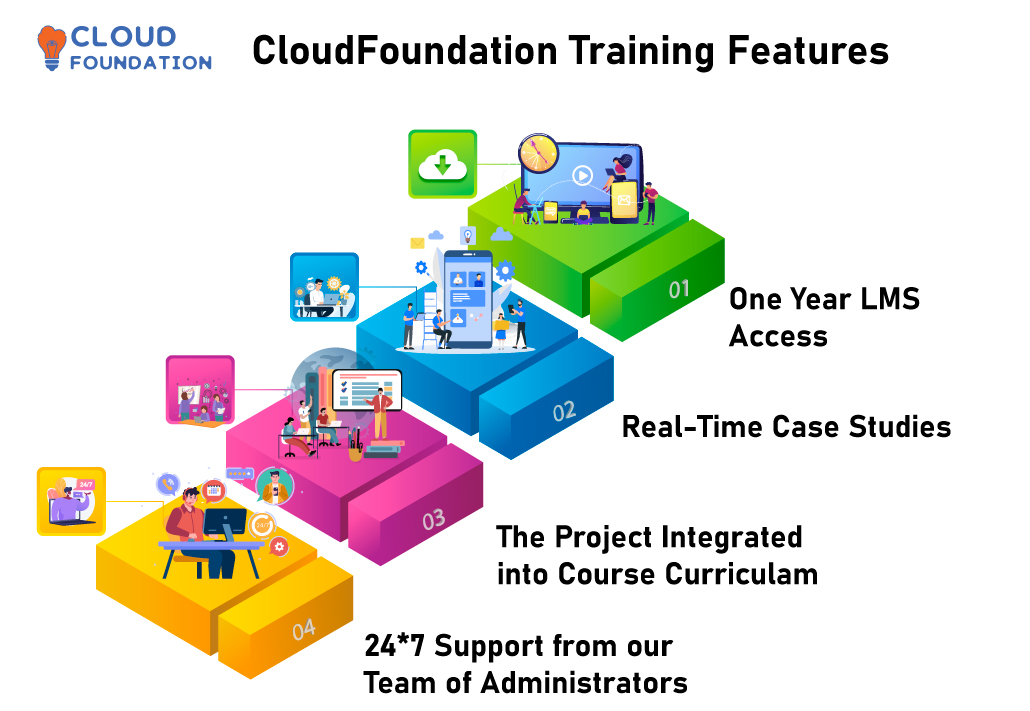Microsoft Azure AZ-300 Training – The only Course you need
⏰26 hours | ▶️ 23 Videos | 📣 12453 Participants | 🎓 6249 Reviews | 4.8 ⭐⭐⭐⭐⭐
Choose a Plan that Works for You
Self Paced
- Advanced sessions
- Interview Q&A
- Free study Materials
- Premium Technical support
Instructor Led Live Training
- Live Instructor
- Advanced sessions
- Interview Q&A
- Premium Technical Support
Corporate Training
- Live Instructor
- Advanced sessions
- Interview Q&A
- Premium Technical Support
Upcoming Batches PST
Weekday
| Nov 06(1 HR A DAY) |
| 06:00 PM PST |
| Enroll Now → |
Weekday
| Nov 26(1 HR A DAY) |
| 06:00 AM PST |
| Enroll Now → |
Weekday
| Nov 22(1 HR A DAY) |
| 07:00 PM PST |
| Enroll Now → |
Upcoming Batches IST
Weekday
| Nov 07(1 HR A DAY) |
| 06:30 AM IST |
| Enroll Now → |
Weekday
| Nov 26(1 HR A DAY) |
| 06:30 PM IST |
| Enroll Now → |
Weekday
| Nov 23(1 HR A DAY) |
| 07:00 AM PST |
| Enroll Now → |
Course Description
Microsoft Azure 300 training covers the core skills of an azure architect that clarifies fundamental technologies that assist as the source for endorsing a design for secure, scalable, and reliable solutions.
The Microsoft Azure 300 certification exam is a proficient level that tests an applicant’s skills on the numerous aspects of Microsoft azure.
Pursue Microsoft azure 300 courses by enrolling with us through self-paced and online classes under proficient trainers with complete tools and support.
Throughout this course, you learn the essential modules such as creating and configuring storage accounts and hands-on experiments for your certification exam.
Note: The Microsoft azure 300 certification exam was replaced by azure 303, which is under development with some new modules.

Deploy and configure infrastructure
Analyze resource utilization and consumption
- configure diagnostic settings on resources
- create baseline for resources
- create and test alerts
- analyze alerts across subscription
- analyze metrics across subscription
- create action groups
- monitor for unused resources
- monitor spends
- report on spend
- utilize Log Search query functions
- view Alerts in Azure Monitor logs
- visualize diagnostics data using Azure Monitor Workbooks
Create and configure storage accounts
- configure network access to the storage account
- create and configure storage account
- generate Shared access signature
- implement Azure AD authentication for storage
- install and use Azure Storage Explorer
- manage access keys
- monitor Activity log by using Azure Monitor logs
- implement Azure storage replication
- implement Azure storage account failover
Create and configure a VM for Windows and Linux
- configure High Availability
- configure Monitoring
- configure Networking
- configure Storage
- configure Virtual Machine Size
- implement dedicated hosts
- deploy and configure scale sets
Automate deployment of VMs
- modify Azure Resource Manager template
- configure Location of new VMs
- configure VHD template
- deploy from template
- save a deployment as an Azure Resource Manager template
- deploy Windows and Linux VMs
Create connectivity between virtual networks
- create and configure Vnet peering
- create and configure Vnet to Vnet connections
- verify virtual network connectivity
- create virtual network gateway
Implement and manage virtual networking
- configure private IP addressing
- configure public IP addresses
- create and configure network routes
- create and configure network interface
- create and configure subnets
- create and configure virtual network
- create and configure Network Security Groups and Application Security Groups.
Manage Azure Active Directory
- add custom domains
- configure Azure AD Identity Protection
- configure Azure AD Join
- configure self-service password reset
- implement conditional access policies
- manage multiple directories
- perform an access review
Implement and manage hybrid identities
- install and configure Azure AD Connect
- configure federation
- configure single sign-on
- manage and troubleshoot Azure AD Connect
- troubleshoot password sync and writeback
Implement solutions that use virtual machines (VM)
- provision VMs
- create Azure Resource Manager templates
- configure Azure Disk Encryption for VMs
- implement Azure Backup for VMs
Implement workloads and security
Migrate servers to Azure
- migrate servers using Azure Migrate
Configure serverless computing
- create and manage objects
- manage a Logic App Resource
- manage Azure Function app settings
- manage Event Grid
- manage Service Bus
Implement application load balancing
- configure application gateway
- configure Azure Front Door service
- configure Azure Traffic Manager
Integrate on premises network with Azure virtual network
- create and configure Azure VPN Gateway
- create and configure site to site VPN
- configure ExpressRoute
- configure Virtual WAN
- verify on premises connectivity
- troubleshoot on premises connectivity with Azure
Implement multi factor authentication
- configure user accounts for MFA
- configure fraud alerts
- configure bypass options
- configure Trusted IPs
- configure verification methods
Manage role-based access control
- create a custom role
- configure access to Azure resources by assigning roles
- configure management access to Azure
- troubleshoot RBAC
- implement Azure Policies
- assign RBAC Roles
Create and deploy apps
Create web apps by using PaaS
- create an Azure app service Web App
- create documentation for the API
- create an App Service Web App for Containers
- create an App Service background task by using Web Jobs
- enable diagnostics logging
Design and develop apps that run-in containers
- configure diagnostic settings on resources
- create a container image by using a Docker file
- create an Azure Kubernetes Service
- publish an image to the Azure Container Registry
- implement an application that runs on an Azure Container Instance
- manage container settings by using code
Implement authentication and secure data
Implement authentication
- implement authentication by using certificates, forms-based authentication, tokens, or Windows-integrated authentication
- implement multi-factor authentication by using Azure AD
- implement OAuth2 authentication
- implement Managed Identities for Azure resources Service Principal authentication
Implement secure data solutions
- encrypt and decrypt data at rest and in transit
- encrypt data with Always Encrypted
- implement Azure Confidential Compute
- implement SSL/TLS communications
- create, read, update, and delete keys, secrets, and certificates by using the Key Vault API
Develop for the cloud and for azure storage
Configure a message-based integration architecture
- configure an app or service to send emails
- configure Event Grid
- configure the Azure Relay service
- create and configure a Notification Hub
- create and configure an Event Hub
- create and configure a Service Bus
Develop for autoscaling
- implement autoscaling rules and patterns (schedule, operational/system metrics
- implement code that addresses singleton application instances
- implement code that addresses transient state
Develop solutions that use Cosmos DB storage
- create, read, update, and delete data by using appropriate APIs
- implement partitioning schemes
- set the appropriate consistency level for operations
Develop solutions that use a relational database
- provision and configure relational databases
- configure elastic pools for Azure SQL Database
- implement Azure SQL Database managed instances
- create, read, update, and delete data tables by using code
Implement and monitor an azure infrastructure
Implement cloud infrastructure monitoring
- monitor security
- monitor performance
- configure diagnostic settings on resources
- create a performance baseline for resources
- monitor for unused resources
- monitor performance capacity
- visualize diagnostics data using Azure Monitor
- monitor health and availability
- monitor networking
- monitor service health
- monitor cost
- monitor spends
- report on spend
- configure advanced logging
- implement and configure Azure Monitor insights, including App Insights,
- Networks, Containers
- configure a Log Analytics workspace
- configure logging for workloads
- initiate automated responses by using Action Groups
- configure and manage advanced alerts
- collect alerts and metrics across multiple subscriptions
- view Alerts in Azure Monitor logs
- NOT: create Log Analytics query
Implement storage accounts
- select storage account options based on a use case
- configure Azure Files and blob storage
- configure network access to the storage account
- implement Shared Access Signatures and access policies
- implement Azure AD authentication for storage
- manage access keys
- implement Azure storage replication
- implement Azure storage account failover
Implement VMs for Windows and Linux
- configure High Availability
- configure storage for VMs
- select virtual machine size
- implement Azure Dedicated Hosts
- deploy and configure scale sets
- configure Azure Disk Encryption
Automate deployment and configuration of resources
- save a deployment as an Azure Resource Manager template
- modify Azure Resource Manager template
- evaluate location of new resources
- configure a virtual disk template
- deploy from a template
- manage a template library
- create and execute an automation runbook
Implement virtual networking
- implement VNet to VNet connections
- implement VNet peering
Implement Azure Active Directory
- add custom domains
- configure Azure AD Identity Protection
- implement self-service password reset
- implement Conditional Access including MFA
- configure user accounts for MFA
- configure fraud alerts
- configure bypass options
- configure Trusted IPs
- configure verification methods
- implement and manage guest accounts
- manage multiple directories
Implement and manage hybrid identities
- install and configure Azure AD Connect
- identity synchronization options
- configure and manage password sync and password writeback
- configure single sign-on
- use Azure AD Connect Health
Implement management and security solutions
Manage workloads in Azure
- migrate workloads using Azure Migrate
- assess infrastructure
- select a migration method
- prepare the on-premises for migration
- recommend target infrastructure
- implement Azure Backup for VMs
- implement disaster recovery
- implement Azure Update Management
Implement load balancing and network security
- implement Azure Load Balancer
- implement an application gateway
- implement a Web Application Firewall
- implement Azure Firewall
- implement the Azure Front Door Service
- implement Azure Traffic Manager
- implement Network Security Groups and Application Security Groups
- implement Bastion
Implement and manage Azure governance solutions
- create and manage hierarchical structure that contains management groups, subscriptions, and resource groups
- assign RBAC roles
- create a custom RBAC role
- configure access to Azure resources by assigning roles
- configure management access to Azure
- interpret effective permissions
- set up and perform an access review
- implement and configure an Azure Policy
- implement and configure an Azure Blueprint
Manage security for applications
- implement and configure KeyVault
- implement and configure Azure AD Managed Identities
- register and manage applications in Azure AD
Implement solutions for apps
Implement an application infrastructure
- create and configure Azure App Service
- create an App Service Web App for Containers
- create and configure an App Service plan
- configure an App Service
- configure networking for an App Service
- create and manage deployment slots
- implement Logic Apps
- implement Azure Functions
Implement container-based applications
- create a container image
- configure Azure Kubernetes Service
- publish and automate image deployment to the Azure Container Registry
- publish a solution on an Azure Container Instance
- NOT: Service Fabric
Implement and manage data platforms
Implement NoSQL databases
- configure storage account tables
- select appropriate CosmosDB APIs
- set up replicas in CosmosDB
- Implement Azure SQL databases
- configure Azure SQL database settings
- implement Azure SQL Database managed instances
- configure HA for an Azure SQL database
- publish an Azure SQL database
FAQ’s
❓ Do you offer any discount/offer?
✅ Yes, offers keep changing from time to time. You can chat with us or call our training coordinator for more details.
❓ Is there any demo video which I can watch before enrolling to the course?
✅ Yes, we have provided a Demo video section on each course page so that you can get a glimpse into the course you want to enroll.
❓ How soon after signing up would I get access to the learning content?
✅ Yes, we will provide access to all the learning materials after the complete payment for the course.
Suggested Courses




Blue Prism Training
⭐⭐⭐⭐⭐
😃 320 Learners




Robotic Process Automation (RPA) Training
⭐⭐⭐⭐⭐
😃 331 Learners




OpenSpan Training
⭐⭐⭐⭐⭐
😃 30 Learners




Automation Anywhere
⭐⭐⭐⭐⭐
😃 112 Learners
A few of our students
















Contact Us